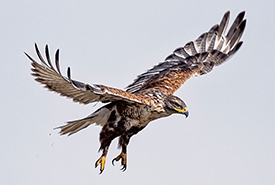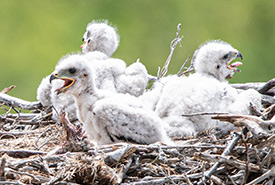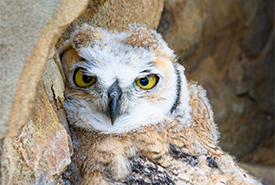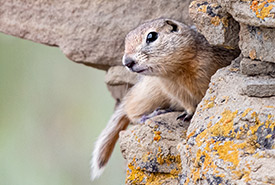The raptors of McIntyre Ranch
The grasslands of McIntyre Ranch provide ideal habitat for many birds of prey
Ferruginous hawk (Photo by Leta Pezderic / NCC Staff)
McIntyre Ranch, nestled within the grasslands of southern Alberta, is home to a remarkable array of raptor species. From majestic golden eagles to swift prairie falcons, it teems with avian diversity. The ranch serves as a vital habitat for these raptors, offering an oasis of resources and nesting opportunities amidst the vast prairie landscape.
The diversity of raptors on the ranch makes for some stunning displays.
“One day I was in a field and watching two or three eagles up in the sky, when a red-tailed hawk came in, then a prairie falcon and then a ferruginous hawk — that’s a lot of different species all in one airspace,” says Leta Pezderic, grassland stewardship manager for the Nature Conservancy of Canada (NCC) in Alberta.
While spending the past several years working toward conserving the McIntyre Ranch, Leta, an avid wildlife photographer, has captured many of these stunning animals while admiring their power and beauty.
Bastion of a big hawk
One of the most impressive raptor species found on McIntyre Ranch — and one of Leta’s favourites to photograph — is ferruginous hawk, a threatened species in Canada.

Oisillons de buse rouilleuse (Photo de Leta Pezderic/CNC)
The number of ferruginous hawks in Alberta has declined, leaving them vulnerable to various threats. Habitat loss, pesticide exposure and disturbances during nesting pose significant challenges for this hawk, the largest in Canada. However, concerted efforts are underway to conserve and restore suitable nesting habitats for this species, particularly the grasslands, which are crucial to their survival.
Given their population declines, the number of ferruginous hawks that can still be seen at McIntyre Ranch is simply incredible, says Leta.
“When you come visit McIntyre Ranch, it seems there is no way ferruginous hawks are a threatened species, because they seem so plentiful,” says Leta. “But that’s because they have this little oasis of habitat, so they are thriving there.”
Enjoying this story? Sign up for our newsletter!
Nesting here or there
One of the reasons why McIntyre Ranch supports such a diversity of raptors, which also includes species such as golden eagle, Swainson’s hawk, short-eared owl, prairie falcon and northern harrier, is the large variety of nesting sites it offers, which include beautiful sandstone cliffs and the odd cottonwood tree.
Prairie raptors demonstrate remarkable adaptability when it comes to nest site selection. These birds use a range of nesting options based on their specific requirements and the availability of suitable locations.

Grand-duc d'Amérique juvenile (Photo Leta Pezderic/CNC)
While some prairie raptors construct their nests on the ground amidst tall grasses, others prefer elevated sites like trees, cliffs or man-made structures, such as power poles, sheds and cow shelters. Ground-nesting raptors often create shallow depressions or “scrape nests,” allowing them to camouflage and protect their eggs and young. However, raptors that secure elevated sites benefit from increased visibility and protection from ground-based predators.
Ferruginous hawks are one of the most adaptable species. While many are ground nesters, others occupy large stick nests on cliffs, trees or even small shrubs, which can make for a comical sight, says Leta.
“Sometimes you will see them nesting on a tiny little shrub, and the nest is massive and teetering. It’s quite humorous,” says Leta.
Raptors compete fiercely over nest sites. For example, a nest in a grove of planted cottonwood trees on McIntyre Ranch was once occupied by a pair of ferruginous hawks, but has been taken over by a pair of bald eagles.
“There’s always this massive battle in the spring for the nest,” says Leta.
Because nest sites can be limited for ferruginous hawks, sometimes conservation organizations such as NCC will help by installing artificial nesting platforms on poles for these birds to nest on.
The diverse nesting strategies employed by prairie raptors highlight their ability to adapt to different habitats and optimize their chances of successfully reproducing in the vast and dynamic prairie landscape.
Want to help grassland species? Consider supporting NCC's Prairie Grasslands Action Plan!
Food for all
Richardson’s ground squirrels, an overlooked but vital contributor to the prairie ecosystem, play a pivotal role in supporting raptor populations at McIntyre Ranch. Despite being viewed by some as pests, ground squirrels are, in fact, keystone species in the grasslands.
These small, burrowing rodents serve as a significant food source for both birds and mammals, contributing to the intricate web of life in the prairie. They provide sustenance for a range of predators, including raptors, coyotes, badgers, snakes and foxes.

Spermophile de Richardson (Photo Leta Pezderic/CNC)
Richardson’s ground squirrels are native to the northern Great Plains, and they are predominately found in native grassland habitat. So, it makes sense that where you find native grasslands, you will likely find Richardson’s ground squirrels, and where you find ground squirrels, you will find birds of prey.
“When you’re driving along the highway heading toward the ranch, it’s mostly cropland and you tend to see very few ground squirrels or raptors,” says Leta. “But then all of a sudden, when you come to the boundary of the ranch, it’s a night and day difference. Ground squirrels are plentiful, and you start seeing eagles and hawks on almost every other power pole along the highway.”
Beyond their role in the food web, ground squirrels also influence plant communities by selectively foraging on seeds, bulbs and plant shoots, shaping the composition and distribution of plant species. Their burrows also offer shelter and habitat for other species, such as insects and snakes, further enhancing the overall biodiversity of the ranch.
While ground squirrels provide benefits, they can also cause problems if their population numbers get too high. But having raptors nearby can keep their numbers in check. For example, a nesting pair of ferruginous hawks and their offspring can consume up to 500 ground squirrels in a season.
“When we offer a landowner to set up a nesting pole for a ferruginous hawk nest, we stress the benefits of having hawks on a property. They will help control the amount of ground squirrels in a natural way rather than succumbing to using other more common control methods, such as poison, which can have a detrimental effect on all the species that are a part of that food chain,” says Leta.
Conserving a raptor paradise
McIntyre Ranch stands as a testament to the delicate interplay between raptors, their nesting preferences, and the vital role of ground squirrels within the prairie ecosystem. The ranch's commitment to conservation and the protection of native habitats has created a haven for raptors, allowing them to flourish against the backdrop of Alberta's grasslands. And now that McIntyre Ranch has been conserved in perpetuity, these raptors will have a home forever.




